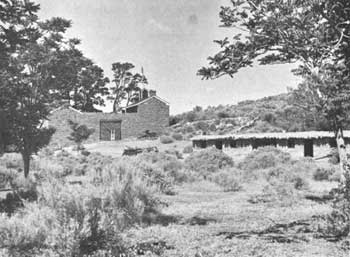





Survey of Historic Sites and Buildings
 |
PIPE SPRING NATIONAL MONUMENT Arizona |
 |
| ||
The Mormon extension southward from the Salt Lake Basin and the achievements of the southwestern pioneers are exemplified in this national monument. In the 1850's the Mormons began dispersing from the basin to locations in southern Utah and northern Arizona that provided water. As centers of defense against Indian attacks and way stations for travelers, they established at strategic locations a series of forts, such as Pipe Spring in Arizona and Cove Fort and Fort Deseret in Utah. Pipe Spring National Monument contains probably the best remaining example of such a fort.
Although the Dominguez-Escalante Expedition of 1776 passed nearby, the first white men known to have visited Pipe Spring were members of the Jacob Hamblin party, who camped there in 1858. They had been sent out by Brigham Young to explore and report on the Colorado River country and to try to negotiate a treaty of peace with the Navajos living on the south side of the river. Between 1863 and 1865 Pipe Spring was the headquarters of a cattle ranch run by a Mormon, but some marauding Navajos killed the inhabitants.
 |
| Pipe Spring National Monument. (National Park Service) |
In 1869 the Mormon Church acquired the property. Within a couple of years Bishop Anson P. Winsor built a fort that became known as "Winsor Castle." It consisted of two redstone buildings, two stories high, facing each other across a courtyard. Sandstone walls and heavy gates enclosed its sides. The firing platform just below the top of one wall and the associated loopholes remaining today were designed to withstand Indian attacks. A continuous flow of water was insured, for one of the buildings stood directly over a spring. Bishop Winsor left Pipe Spring about 1875. The place became important as a cattle ranch and as the starting point for cattle drives to the railroad at Lund, Utah, about 100 miles away.
Park rangers conduct tours of the fort and outbuildings. Exhibits feature pioneer tools and furnishings.
 |
 |
http://www.cr.nps.gov/history/online_books/soldier-brave/sitea5.htm
Last Updated: 19-Aug-2005